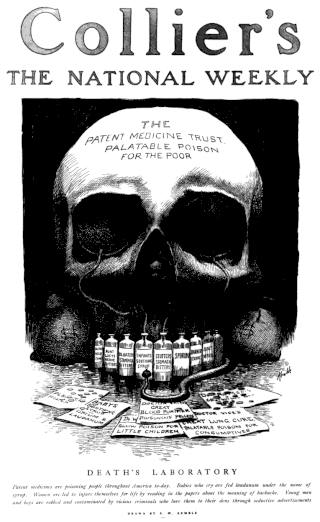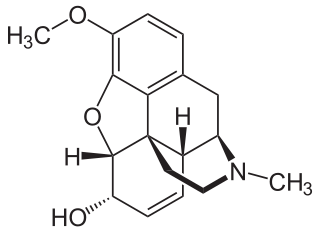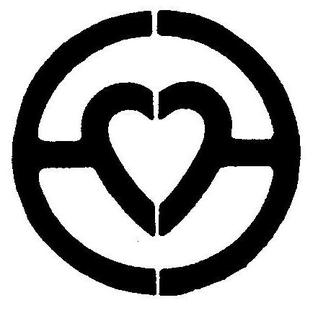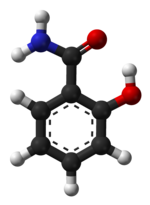
A patent medicine is a non-prescription medicine or medicinal preparation that is typically protected and advertised by a trademark and trade name, and claimed to be effective against minor disorders and symptoms, as opposed to a prescription drug that could be obtained only through a pharmacist, usually with a doctor's prescription, and whose composition was openly disclosed. Many over-the-counter medicines were once ethical drugs obtainable only by prescription, and thus are not patent medicines.

Phenacetin is a pain-relieving and fever-reducing drug, which was widely used following its introduction in 1887. It was withdrawn from medicinal use as dangerous from the 1970s.
Oxycodone/aspirin is a combination drug marketed by Endo Pharmaceuticals. It is a tablet containing a mixture of 325 mg of aspirin and 4.8355 mg of oxycodone HCl ; it is an opioid/non-opioid combination used to treat moderate to moderately severe pain. The safety of the combination during pregnancy has not been established, although aspirin is generally contraindicated during pregnancy, and the drug has been placed in pregnancy category D. Inactive ingredients include D&C Yellow 10, FD&C Yellow 6, microcrystalline cellulose, and corn starch. Percodan was first marketed by DuPont Pharmaceuticals and prescribed in the United States in 1950. Once a widely prescribed painkiller, it has largely been replaced by alternative oxycodone compounds containing paracetamol (acetaminophen) instead of aspirin, such as Percocet.

Dihydrocodeine is a semi-synthetic opioid analgesic prescribed for pain or severe dyspnea, or as an antitussive, either alone or compounded with paracetamol (acetaminophen) or aspirin. It was developed in Germany in 1908 and first marketed in 1911.

Excedrin is an over-the-counter headache pain reliever, typically in the form of tablets or caplets. It contains paracetamol, aspirin and caffeine. It was manufactured by Bristol-Myers Squibb until it was purchased by Novartis in July 2005 along with other products from BMS's over-the-counter business. As of March 2015, GSK holds majority ownership of Excedrin through a joint venture transaction with Novartis. On July 18, 2022, GSK spun off its consumer healthcare business to Haleon.

Co-codaprin (BAN) is a compound analgesic, a combination of codeine phosphate with aspirin.

Butalbital is a barbiturate with an intermediate duration of action. Butalbital is often combined with other medications, such as paracetamol (acetaminophen) or aspirin, for the treatment of pain and headache. The various formulations combined with codeine are FDA-approved for the treatment of tension headaches. Butalbital has the same chemical formula as talbutal but a different structure—one that presents as 5-allyl-5-isobutylbarbituric acid.
BC Powder is an American brand of over-the-counter analgesic pain reliever owned by Prestige Consumer Healthcare and manufactured in Washington, DC.

Midol is a brand of over-the-counter analgesic drugs marketed for menstrual cramping and other effects related to premenstrual syndrome and menstruation. Various subbrands are formulated using different active ingredients. Midol is distributed by Bayer.
Goody's Powder, also called Goody's Headache Powders, is an over-the-counter aspirin/paracetamol/caffeine–based pain reliever, in single-dose powder form, which is marketed and sold by Prestige Brands. The powder delivery saves the time needed for the patient's digestive system to break down a tablet or capsule, ostensibly causing the medication to work faster. Goody's Extra Strength Powder consists of aspirin, caffeine, and paracetamol (acetaminophen) in a formula identical to that of Excedrin, a product of Novartis, but in the no-digestion-needed powder form.

Anacin is an American brand of analgesic that is manufactured by Prestige Consumer Healthcare. Anacin's active ingredients are aspirin and caffeine.

Ethenzamide (2-ethoxybenzamide) is a common analgesic and anti-inflammatory drug that is used for the relief of fever, headaches, and other minor aches and pains. It is also an ingredient in numerous cold medications and many prescription analgesics. It is used as an over-the-counter drug in Japan, often in combination with caffeine and acetaminophen, where it is marketed for uses including toothache, menstrual cramps, headache, and fever.
Propyphenazone/paracetamol/caffeine is an analgesic combination indicated for the management of headache. It contains the analgesics propyphenazone and paracetamol and the stimulant caffeine.
Compound analgesics are those with multiple active ingredients; they include many of the stronger prescription analgesics.
A combination drug or a fixed-dose combination (FDC) is a medicine that includes two or more active ingredients combined in a single dosage form. Terms like "combination drug" or "combination drug product" can be common shorthand for an FDC product, although the latter is more precise if in fact referring to a mass-produced product having a predetermined combination of drugs and respective dosages. And it should also be distinguished from the term "combination product" in medical contexts, which without further specification can refer to products that combine different types of medical products—such as device/drug combinations as opposed to drug/drug combinations. When a combination drug product is a "pill", then it may also be a kind of "polypill" or combopill.

Codeine is an opiate and prodrug of morphine mainly used to treat pain, coughing, and diarrhea. It is also commonly used as a recreational drug. It is found naturally in the sap of the opium poppy, Papaver somniferum. It is typically used to treat mild to moderate degrees of pain. Greater benefit may occur when combined with paracetamol (acetaminophen) or a nonsteroidal anti-inflammatory drug (NSAID) such as aspirin or ibuprofen. Evidence does not support its use for acute cough suppression in children. In Europe, it is not recommended as a cough medicine for those under 12 years of age. It is generally taken by mouth. It typically starts working after half an hour, with maximum effect at two hours. Its effects last for about four to six hours. Codeine exhibits abuse potential similar to other opioid medications, including a risk of addiction and overdose.

The Beecham Group plc was a British pharmaceutical company. It was once a constituent of the FTSE 100 Index. Founded by Thomas Beecham who opened the first factory in St Helens, Lancashire in 1859, Beecham focused on marketing the business by advertising in newspapers and using a network of wholesale agents in northern England and in London, rapidly building up the business. In August 1859 he created the slogan for Beecham's Pills: "Worth a guinea a box", considered to be the world's first advertising slogan, which helped the business become a global brand.
Aspirin/paracetamol/caffeine is a combination drug for the treatment of pain, especially tension headache and migraine. It contains aspirin, a non-steroidal anti-inflammatory drug; paracetamol (acetaminophen), an analgesic; and caffeine, a stimulant.
Vincent Chemical Company was an Australian business noted for manufacture of a popular compound analgesic "Vincent's APC"













